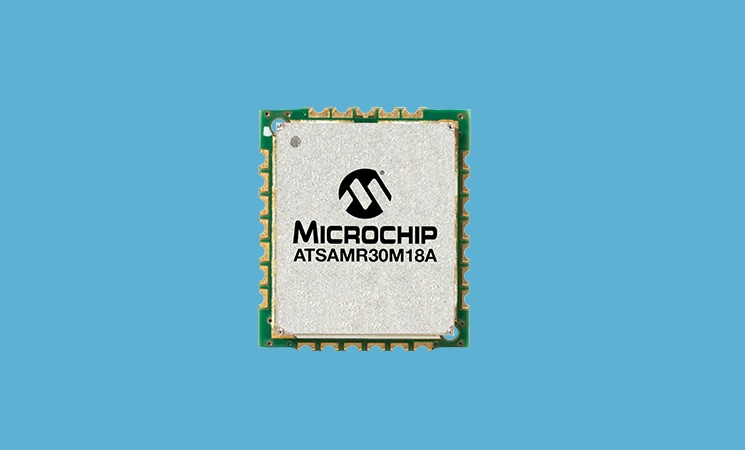Predictive Maintenance for Industry 4.0
Aligning the appropriate Microchip MCU and MPU families with our easy-to-use development tools enables developers to create optimal designs for predictive maintenance applications without the risks, higher system costs and slower time-to-market than they might encounter with less-integrated approaches.
Industry 4.0 often refers to our evolution to automated processes driven by advanced technologies including artificial intelligence (AI), machine learning (ML), hyperscale cloud computing, the Industrial Internet of Things (IIoT), and smart robotics.
Proponents of Industry 4.0 expect it to have a disruptive and transformative impact on the economy, businesses, jobs and society-at-large.
Many predict that this fourth industrial revolution will be different from earlier revolutions because of its effect on the nature of work and the future of our increasingly-interconnected society. The way we work, the way we are trained, the way we are educated, the way we play and the way we live will all be transformed. But are we ready?
Many of us remember learning about the first Industrial Revolution in elementary school, but we have been living through an equally-dynamic era that seems to transform all kinds of business processes every few years.
Low-cost gene sequencing and techniques such as CRISPR (Clustered Regularly Interspaced Short Palindromic Repeats) massively expand our ability to edit the building blocks of life. Artificial intelligence is augmenting processes and enhancing human skills in just about every industry. Neurotechnology is making unprecedented strides in helping us understand cognition and influence brain health. And now, AI is being applied to industrial automation and disrupting century-old transport and manufacturing paradigms.
At one time, factories scheduled their annual shutdowns to give employees time for holidays and time away from the assembly line. These breaks also allowed routine maintenance to be performed and new machinery to be installed. Typical shutdowns for scheduled maintenance could last a week or two, while new product introductions might mandate extensive retooling that could take a month or more.
Today, factories aim for levels of flexibility that were impossible in the recent past. They need to ramp up to meet spikes in demand, scale back when supply chain flows waver and ramp right back to take advantage of business conditions.
Industry 4.0 will blur the lines between physical, digital, and biological spheres, enabling us to build a new virtual world from which we can steer the physical world. A new wave of maturing technologies will allow us to connect production equipment and enable that equipment to interact with us (and our information systems) in real time.
Predictive Maintenance in the Automated Factory
Industrial robotic systems see increasing levels of vibration on their mechanical elements which often indicates the need for service. Factory operations personnel need to find a way to increase their awareness of vibration and use AI/ML analytics to interpret the data and address the issue in a timely manner. This is a fairly standard interpretation of predictive maintenance that many Industry 4.0 advocates aspire to.
In the past, service schedules were compiled using a paper log file, and the intervals between were often decided arbitrarily by a supervisor based on their experience and feel for the operation. As robotic systems in modern manufacturing become more complex, factory managers need to be aware of their maintenance requirements in real time and be on top of both routine and critical service scheduling in order to avoid an interruption in service.
Over the years, manufacturing and service personnel have become accustomed to the advances offered by computerized maintenance management systems (CMMS) and reliability-centered maintenance (RCM) approaches that are fed by operational data. The move to predictive maintenance models will incorporate waves of new data to deliver unprecedented insights and actions.
An Integrated Solution for the Modern Factory
The hyper-aware status of operational assets and the related collection of conditional and performance data is paramount to a smart factory’s evolution. And these increasing volumes of data will be best analyzed at the edge – and instantly.
Microchip offers a fully-integrated, state-of-the-art technology solution for Linux applications that can be readily applied to evolutionary designs. We have connected all the dots, enabling our customers to efficiently design next-gen solutions in a smart, connected and secure manner.
This application of IoT technology is ideal for those managing a sensor network while controlling robotic systems and reporting data through a human machine interface (HMI).
An Integrated Approach to the Challenges of Automation
Aligning the appropriate Microchip microcontroller and microprocessor families with our easy-to-use development tools enables developers to create optimal designs for predictive maintenance applications without the risks, higher system costs and slower time-to-market that may might encounter with less-integrated approaches.
For example, our SAMA5D27 MPU can be deployed to drive the robotic operations for typical factory automation scenarios such as moving, cutting, bending, pressing or connecting pieces or parts altogether. The SAMA5D27 also collects and processes sensor data, reports the status of its operation, supports directives, provides an emergency shut down mode and monitors its environment for actionable maintenance-related information. Sensors are connected to the gateway through a sub-GHz network, based on our SAMR30M module, which supports IEEE 802.15.4 PHY based protocols.
Predictive Maintenance with Enabling Technology from Microchip
The advanced capabilities of predictive maintenance are being embraced today in factories around the world. State-of-the-art neural networks and embedded sensors are used to accurately predict potential maintenance issues with equipment used in a variety of industrial, manufacturing, consumer, automotive and other applications. We have made it easy to leverage the Internet of Things with a combination of solutions to monitor and detect wear and tear and operational anomalies that might be affecting the performance of industrial gear in the field while also implementing smart control to manage load and reduce the amount of wasted power. Predictive maintenance reduces downtime and repair costs while also extending equipment life and ensuring output quality.
By partnering with industry-leading solution providers, we can offer a complete predictive maintenance solution that use multiple sensors, account for vibration sensing extremes and enable advanced AI/ML capabilities and features.
We offer a dedicated internal Linux application team, target Long-Term Support (LTS) Linux releases and offer support for official LTS kernels to reduce risk and reduce development times. We can deliver this integrated solution set to your predictive maintenance projects with a total solution approach based on key elements from our product portfolio:
Microchip PIC32 Microcontrollers
Our PIC32 family of low pin-count, 32-bit PIC32 microcontrollers provides 83 DMIPS of performance at only 50 MHz with the right mix of peripherals for cost-sensitive general-purpose sensing. Rated for operation up to 105°C, the PIC32MX1 / MX2 MCUs include an integrated hardware peripheral for adding mTouch™ capacitive touch buttons or advanced sensors.
Microchip SAMA5D27 Microprocessors
The SAMA5D27 is a high-performance, low-power embedded microprocessor (MPU) running up to 500 MHz, with support for multiple memories such as DDR2, DDR3L, LPDDR2, LPDDR3, and QSPI and e.MMC Flash. The device integrates powerful peripherals for connectivity and user interface applications, and offers advanced security functions. The SAMA5D27 is qualified for extended industrial temperature range operation (-40°C to 105°C external temperature).
Microchip Wi-Fi Controllers and SAMR30 Sub-GHz Microcontrollers
Our integrated solution features industry-leading Wi-Fi controllers and sub-GHz microcontrollers along with a comprehensive firmware ecosystem to enable sensor to cloud connectivity via Amazon Web Services, Microsoft Azure and Google Cloud platforms.
Our IEEE 802.11 b/g/n IoT network controllers deliver reliable Wi-Fi and network capabilities and connect to any SAM or PIC MCU with minimal resource requirements. With fully integrated power amplifier, LNA, switch and power management features, these devices also provide internal Flash memory to store firmware.
Our low-power SAM R30 series of products utilize IEEE 802.15.4 in the sub-GHz channels of the ISM band. Their ultra-low-power sleep modes, which consume less than 1 uA, also enable your products to meet the standard’s defined ability to sleep virtually forever.
By aligning our Wi-Fi portfolio with a dedicated Linux ecosystem, we have further simplified the development process for our customers. In addition to the AWS-IoT and AWS-Greengrass functionality, we can also offer integrations with Google Cloud and Microsoft Azure approaches.
Microchip Trust Platform and ECC608B Secure Element
Our Trust Platform is a cost-effective and flexible solution for onboarding our secure elements in your design and accelerating your product’s time to market. The Trust Platform is composed of a family of pre-provisioned, pre-configured or fully customizable secure elements. Credentials are generated inside each secure element’s boundary by leveraging our Hardware Secure Modules (HSMs) that are installed in our factories. The devices also come with hardware and software development tools to make prototyping easy and to fast track your development.
The ATECC608B is a secure element from the our CryptoAuthentication™ portfolio with advanced Elliptic Curve Cryptography (ECC) capabilities. With ECDH and ECDSA being built right in, this device is ideal for the rapidly growing IoT market by easily supplying the full range of security such as confidentiality, data integrity, and authentication to systems with MCU or MPUs running encryption/decryption algorithms. Similar to all Microchip CryptoAuthentication products, the new ATECC608A employs ultra-secure hardware-based cryptographic key storage and cryptographic countermeasures which eliminate potential backdoors linked to software weaknesses.
Coming Soon: Our latest use case on predictive maintenance and the products, software and support services to keep you on the path to Industry 4.0.


